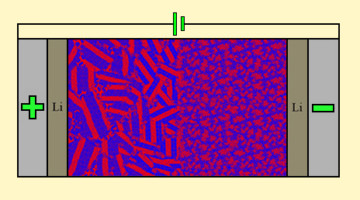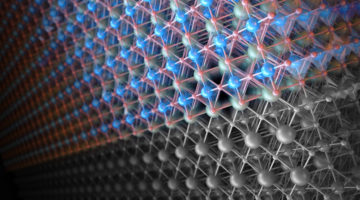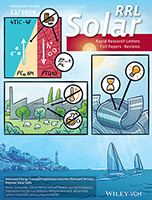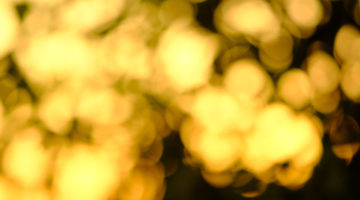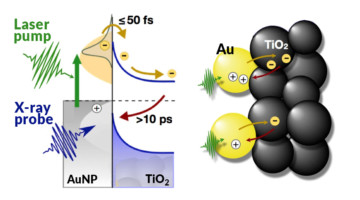Electrocatalysts, particularly those for water oxidation, often experience substantial or at least partial reconstruction. Here, Wang et al. are able to control surface reconstruction using a cationic redox-tuning method on layered LiCoO2–xClx catalysts for the oxygen evolution reaction. The resulting optimized catalyst exhibits excellent electrocatalytic performance in alkaline electrolyte. Read more »
Probing Composite Materials to Make Better Batteries
Researchers found that when an ion-conducting polymer composite is placed in an electric field, it forms ion-rich hotspots that continue to grow for hours after the field is removed. The study opens a new path to understanding the dynamic structure of composite materials for smaller, lighter batteries. Read more »![]()
![]()
A 1-Atom-Deep Look at a Water-Splitting Catalyst
X-ray experiments revealed an unexpected transformation in a single atomic layer of a material that contributed to a doubling in the speed of a chemical reaction—the splitting of water into hydrogen and oxygen gases. This process is a first step in producing hydrogen fuel for applications such as electric vehicles powered by hydrogen fuel cells. Read more »
Speeding Toward Improved Hydrogen Fuel Production
Researchers synthesized a material that speeds up one of the limiting steps in extracting hydrogen from alcohols. The catalyst cleanly and efficiently accelerates the removal of hydrogen atoms from a liquid chemical carrier. The material is robust, made from earth-abundant metals, and will help make hydrogen a viable energy source for a wide range of applications. Read more »
New Insights into Lithium-Metal Surface Reactions for Next-Generation Batteries
In this work, researchers studied how CO2 gas modifies the chemical composition of lithium-metal surfaces. A better understanding of the interactions between lithium and surrounding gases will help design stabilization strategies and move from lithium-ion technology to high-energy-density technologies based on lithium metal. Read more »
Balanced Charge Transport Optimizes Industry‐Relevant Ternary Polymer Solar Cells
In this article, Szymanski et al. develop novel, cost‐effective ternary polymer solar cells printed in semi‐industrial conditions from a relatively benign ink, which do not require any further processing. These solar cells show good stability and efficiency due to balanced charge-carrier mobilities achieved by optimizing the composition and morphology. Read more »
Design and synthesis of high performance flexible and green supercapacitors made of manganese‐dioxide‐decorated alkali lignin
Researchers synthesized a plant‐based composite electrode for use in flexible supercapacitors and used synchrotron x‐ray microtomography to better understand the impact of microstructure and morphology on electrode porosity and electrical conductance. Read more »
Coming Down the Pike: Long-Haul Trucks Powered by Hydrogen Fuel Cells
DOE has announced several major investments to take hydrogen fuel cells to the next level, and Berkeley Lab is set to play a leading role. Ten DOE national labs have been selected to participate in two new consortia and a third continuing one to improve the durability, lifetime, and efficiency of fuel cells. Read more »
Scientists Capture Candid Snapshots of Electrons Harvesting Light at the Atomic Scale
A team of scientists has gained important new insight into electrons’ role in the harvesting of light in gold/TiO2 nanoparticle photoelectrochemical (PEC) systems. The scientists say that their study can help researchers develop more efficient material combinations for the design of high-performance solar fuels devices. Read more »
A Probe of Light-Harvesting Efficiency at the Nanoscale
Using time-resolved experiments at the ALS, researchers found a way to count electrons moving back and forth across a model interface for photoelectrochemical cells. The findings provide real-time, nanoscale insight into the efficiency of nanomaterial catalysts that help turn sunlight and water into fuel through artificial photosynthesis. Read more »![]()
![]()
- « Previous Page
- 1
- …
- 6
- 7
- 8
- 9
- 10
- …
- 16
- Next Page »

